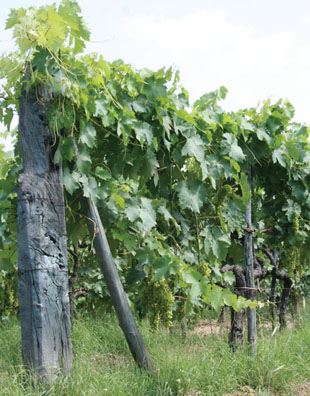 The “Winkler Scale” or “UC Davis Heat Summation Scale,” which measures what are dubbed “degree days,” is only a rough guide to which varietals will thrive in which areas and is solely based on temperature. Basically, it looks at the temperature during the growing season, April 1 to October 31, which roughly brackets bud break to harvest in most areas of the northern hemisphere. The number of “degree days” is equal to the number of degrees Fahrenheit over 50 °F, based on average daily temperature, summed up for all the days in that period. For instance, if the average temperature is 76 °F on August 1, then the degree days for August 1 is 26. UC-Davis provides ranges of degree days that are divided into “regions” with accompanying recommended grape varietals:
The “Winkler Scale” or “UC Davis Heat Summation Scale,” which measures what are dubbed “degree days,” is only a rough guide to which varietals will thrive in which areas and is solely based on temperature. Basically, it looks at the temperature during the growing season, April 1 to October 31, which roughly brackets bud break to harvest in most areas of the northern hemisphere. The number of “degree days” is equal to the number of degrees Fahrenheit over 50 °F, based on average daily temperature, summed up for all the days in that period. For instance, if the average temperature is 76 °F on August 1, then the degree days for August 1 is 26. UC-Davis provides ranges of degree days that are divided into “regions” with accompanying recommended grape varietals:
Region I: Below 2,500 degree days; Chardonnay, Pinot Noir, Gewürztraminer, Riesling
Region II: 2,500-3,000 degree days; Cabernet Sauvignon, Merlot, Sauvignon Blanc
Region III: 3,000-3,500 degree days; Zinfandel, Barbera, Gamay
Region IV: 3,500-4,000 degree days; Malvasia, Thompson Seedless
Region V: Over 4,000 degree days; Thompson Seedless, other table grapes
As you can see, your 1,200 degree days is Region I or below (is that a “Region 0”?) and so Chardonnay, Pinot Noir, Gewürztraminer, and Riesling are the European grape varietals (Vitis vinifera) that you would probably have the most luck with.
As I said above, however, this scale only takes temperature into account and certainly not slope, aspect, microclimate, weather, precipitation, pest species in an area, trellising or soil composition. As you can see there are a myriad of things that can influence the success (or not) of a particular grapevine species. For example, I’m from a little surf town south of Santa Barbara called Carpinteria. If you look at its heat summation units, I should be able to do well with Region I fruit — like you, summer days typically hang out in the high 70s or low 80s °F (25–28 °C). However, Pierce’s Disease, brought on by the glassy wing sharpshooter insect, is a major deterrent to successful vineyards in the area. That and the fact that it doesn’t get very cold at night really means that Carpinteria does best with what it’s most famous for: Citrus, avocados, and flowers.
I would talk to your local university extension, county extension or farm bureau folks. Likewise, take a cue from what other farmers in your area have planted and see what you think you could do. If you need to maximize the heat that you do have, try planting vines on a south-facing slope, or a spot that is sheltered from big ocean breezes that may stress vines too much. If all else fails, try some Vitis vinifera hybrids like Marechal Foch or Leon Millot that are tailor-made for cooler areas.




